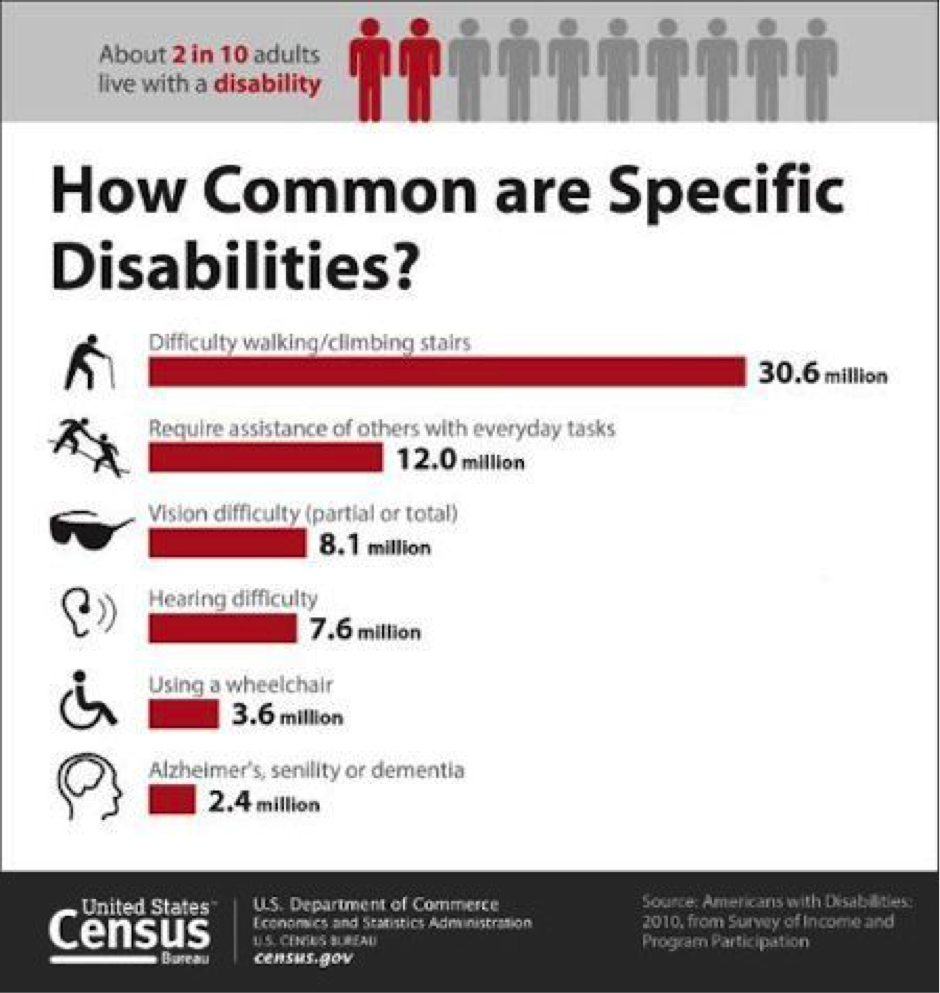Greetings from the Disability and Other Vulnerable Population (DOVP) TIG! We are the DVOP leadership team, Caitlyn Bukaty, June Gothberg, and Sarah von Schrader. This week we’re excited to share a series of posts focused on inclusive evaluation.
Today we want you to consider: Who’s taking part in evaluation? In many cases the group of stakeholders can be quite broad – professionals, consumers, customers, clients, students, families – across the many facets of evaluation the list expands quickly. Given the wide range of people who can participate in evaluation it’s important to design evaluation with everyone in mind.
As leaders of the DOVP TIG our mission is to support the field of evaluation in building practices that make evaluation accessible to everyone, including individuals with disabilities. According to the United States Centers for Disease Control (CDC) almost 1 in 5 people in the United States have a disability1,2. The World Health Organization estimates a similar figure globally3 accounting for about 1 billion people in the world.

This means that if you are conducting evaluation it’s highly likely that some of your stakeholders have a disability, whether or not you are working with a specific population of individuals with disabilities.
Some individuals with disability may face specific barriers to participation and use in an evaluation. For example, individual with a vision impairment may use a screen reader. By preparing surveys and reports to be accessible with screen readers, this population can participate in evaluation independently. Individuals with language difficulties or cognitive impairments may benefit from shorter, more direct surveys or alternative response options. The figure people offers insight into the prevalence of specific disabilities, which may help you decide what accessibility features to incorporate.

This week we will offer you a range of insightful posts centered on designing evaluations to reach as many stakeholders as possible. We know that we can’t cover everything in a week, so we encourage you to reach out, follow up, ask questions, and get involved with the DOVP TIG so that we can work together to create evaluation for all!
Rad Resources:
National and State level Health and Demographic information about adults with disabilities
References:
1 Centers for Disease Control and Prevention (2015). CDC: 53 million adults in the US live with a disability. Retrieved from http://www.cdc.gov/media/releases/2015/p0730-us-disability.html
2 Courtney-Long, E. A., Carroll, D. D., Zhang, Q. C., Stevens, A. C., Griffin-Blake, S., Armour, B. S., & Campbell, V. A. (2015). Prevalence of disability and disability types among adults – United States, 2013. Morbidity and Mortality Weekly Report, 64(29), 777–783.
3 World Health Organization. (2011). World report on disability (p. 325). Malta. Retrieved from http://www.who.int/disabilities/world_report/2011/en/
The American Evaluation Association is celebrating the Disabilities and Other Vulnerable Populations TIG (DOVP) Week. The contributions all week come from DOVP members. Do you have questions, concerns, kudos, or content to extend this aea365 contribution? Please add them in the comments section for this post on the aea365 webpage so that we may enrich our community of practice. Would you like to submit an aea365 Tip? Please send a note of interest to aea365@eval.org . aea365 is sponsored by the American Evaluation Association and provides a Tip-a-Day by and for evaluators.

Hi,
Thank you posting about such an important topic. I am so thrilled to see a discussion about adapting evaluation for people with disabilities. I am a special education teacher which means I am constantly adapting, accommodating and evolving with my students and their needs. When conducting an assessment, I am catering the child’s strengths to ensure they succeed to the best of their abilities. However, this does not come easy. It has taken lots of trials and lots of errors to figure out which assessment methods best suit the student.
That being said, I want to touch on a serious problem that we see in teacher training programs. There is little to no emphasis on disabilities and how to accommodate them. Most teachers, whether in typical classrooms or not, will have to adapt their style for a disability or learning need. I find it seriously troubling that teachers are not trained in university on different methods to use with their students. It is touched upon so quickly and so superficially, teachers are left in the dark. When we finally graduate and get our own classrooms, we feel overwhelmed and frightened at the thought of disabilities and accommodation because we simply have no idea how to tackle this issue.
My question to you is this: how can we ensure bachelor of education programs have thorough training on disabilities? How can we help teachers develop lessons and assessments that cater to all learning needs in the classroom? How can we make teachers feel confident in their abilities to handle disabilities in the classroom? How can we ensure teachers have a repertoire of ideas to help their students with disabilities?
This is a real and serious issue that young teachers are dealing with. With time we become experts; however, the first few years are exceptionally challenging, overwhelming and daunting.
Thanks for discussing such an important issue.
Best,
Erica
It is interesting how we often do not focus on providing presentations for individuals with disabilities. I am currently writing an evaluation processes for a university course I am taking. I understand and have provided several ways to present the information including audio if needed and the person I am working with has a brain injury which affects her attention and short term memory. I have had to break the presentation and information into smaller parts with headings so that she is able to organize the thought. When I was creating this it didn’t even occurs to me that I was making accommodations for her. Are evaporators expected to make all accommodations or only if they are needed?